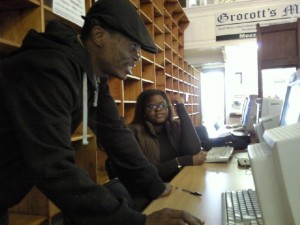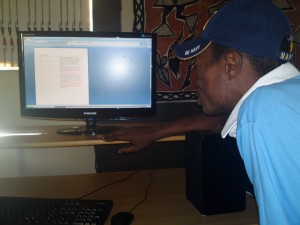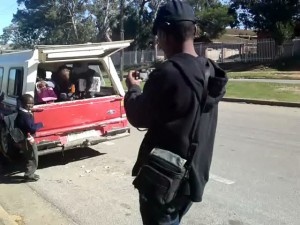This is a profile on Grahamstown Inspector Williams.She is passionate about her job and is proud to be one of the few female inspectors in the male dominated field.She has been successful in striking the right balance between home and work
Working with Thembeni: Citizen journalism
Despite our anxieties, however, luck was on our side. Thembeni was praised by the Chief editor of Grocotts, Kwanele Bhutane as being one of the best citizen journalists Grocotts had, having published several stories on the Grocotts mail website over the last few months. This would be an advantage when it came to finding stories to film because it meant he already had a sense of what was newsworthy and what was not. When we finally did meet, we shared brief hellos and got right down to work. Tamsin and I explained to Thembeni the fundamental aspects of filming stories such as the difference between finding stories for print and finding stories for television. We explained the meaning of terms such as ‘visually compelling’, ‘six second shot rule’ and lighting. His countenance at this point had shifted from jovial to worried (a look we would come to see plenty of over the next few weeks!) and Tamsin and I attempt to calm him repeating that it was not as hard as it sounded to film stories once you ‘got the hang of it’.
For that first week we assigned Thembeni to film a ten second clip of news stories he was already working on for Grocotts as a print stories. The first story was that of the illegal transportation of school children in vans which was deemed unsafe by the South African Government. The second story was covering the march that had been organised by Mary Waters high school students outside the Magistrates court, to protest the bail applications of two men, who allegedly raped a female student from their high school. The clips Thembeni filmed were very good for first attempts at filming and even included a skill we had not taught him, panning! After congratulating him on his work, we wasted no time in planning for the next assignment, a one minute piece which would undoubtedly require more effort on both mine and Tamsin’s side, as well as that of Thembeni.
We agreed that a continuation of the Mary Waters story he would be telling with one of the ten second clips would be ideal and were exhilarated to learn that Thembeni had heard rumours of community members wishing to demolish the abandoned house where the rape occurred. By removing the scene where the horrific incident occurred, the community wanted to show their intolerance for such crimes and prevent a repeat of the same crime befalling another student (since the area around the house was surrounded by schools). In high pitched voices laden with excitement Tamsin and I explained the potential behind capturing bulldozers ripping down walls with community members tearing up, watching on the sidelines. Filming stories had certainly made an impression on what counted as excitement in our lives! Unfortunately when the day came for us to accompany Thembeni to shoot the story, we were disappointed to find that the demolition team consisted of two men who were taking apart the roof and probably would not get around to tearing down the walls until at least 2 weeks later. We did however make the most of it and shot as much footage of pounding hammers as possible instructing Thembeni afterwards on how to shoot sequences. Once again, those familiar worry lines appeared on his face and once again Tamsin told him not to worry!
When Thembeni was free one afternoon we invited him up to the journalism department where we showed him what we meant by sequences by making him watch our how to videos. At that point he understood what we had trying to explain to him and managed to film at least 3 sequential shots for the final story. Up until this point we had suffered no horrendous hiccups, but a large one loomed over us like a dark cloud and would release its might as soon as we would start editing!
Formats formats formats! The one downside of working with cellphone footage is having to change various formats into other formats before using editing software designed for ‘proper cameras’. Despite the problems it gave us, Tamsin and I stuck with Windows Movie maker as we felt it would benefit Thembeni to learn how to edit on it, since he could access it through the Grocotts computers. After converting his footage from QuickTime., to wmv. we started the editing process and quickly learned that Windows Movie Maker was not necessarily as difficult to use as Adobe Premier Pro, (the software we were taught how to use in first term) it was just twice as slow and gave us twice as many problems, freezing constantly. Eventually we did finish editing it, with narration. Thembeni, having worked as a newsreader at Rhodes Music Radio required little guidance apart from pace instruction, when recording his narration.
When reflecting on the whole experience of working with a citizen journalist Tamsin and I agreed that while it was much easier to work with a television crew that knew just as much as you did, it was good feeling to know that you helped teach someone something they otherwise might have never known. The live television show was a pleasant way of marking the end of our working relationships with Thembeni, after all that hard work he was able see what it was all for.
View Thembeni Plaatjie’s story map in a larger map 
Teaching: a two-way process
By Tessa Trafford and Nicole Bloch.
Citizen journalism refers to the gathering, analysing and reporting of news by community members. Grocott’s Mail opened a Citizen journalist Newsroom in September 2009, and has since been training pro-active community members to become journalists. As part of this project, television journalism students from Rhodes University joined with the citizen journalist to further train them in the broadcast medium.
The citizen journalism project turned out to be a challenging journey for us as well as for Noxolo Saki, the citizen journalist. In order to be able to teach more efficiently after a short term of doing television journalism ourselves, we decided to make a manual for Noxolo which included basic information on filming, searching for a story and editing. The first big obstacle however was to get Noxolo a phone with video, as she did not have access to one. It would have been possible to get a different citizen journalist with a phone but we did not want to disappoint Noxolo and we did everything in our power to keep her in our team. A Journalism and Media Studies professor at Rhodes University then provided financial support in order to get Noxolo a phone for the project. The search for a phone and the fact that Noxolo has a two year old child caused huge time constraints. Although Noxolo started out extremely shy and did not know how to look for a good story, she soon came out of her shell and started to show some good results. In order to get some practise Noxolo was required to film a short video clip. Noxolo decided to film a clip on a church group donating boxes of fruit to the House of Joy, where many orphaned children are staying. In the clip, the owner of the house gives thanks to God.
After having had this practice Noxolo started to film for the main project. She focused on a story about litter being dumped behind a crèche in Joza, which is affecting the health of children and angers community members. The crèche is opposite Noxolo’s house making this a personal issue as well as one of great importance to the community. This makes the story hyper-local. One of the major advantages of Citizen Journalism is that community members can let their voices be heard about issues that other journalists may not be aware of.
The highlight of the citizen journalism project was the talkshow, where Noxolo’s video was played alongside that of the other citizen journalists. The video was followed by an in-studio discussion where Noxolo, who was part of the audience, was able take part in the show. To get the full story, plus more pictures and video clips, go to our timeline:
This gives you a timeline, with information and images, of the citizen journalism project.
From this project we learnt that teaching is a two way process. While we taught Noxolo about the world of broadcasting and how to create effective videos with a cell phone, we in turn learnt new skills from Noxolo as well as from the teaching process itself.
RDP Housing Issues in Grahamstown
The Makana Municipality is accused of failing to assist members of Grahamstown east with housing problems caused by the heavy rains experienced last year. Michael Bhusakwe is a victim of Grahamstown’s infrastructural problems and Duduestsang Makuse reports on his situation.
Grahamstown CJ Jennifer Linklater
- Fayo, showing CJ Jenny how to set and take a video using a cellphone
Our experience with a Grahamstown citizen journalist – Jennifer Linklater
At our first meeting with Jennifer, we discovered that apart from being a citizen journalist of Grahamstown, she is also a social worker. She nurses Tuberculosis patients and helps in raising funds for Hospice. She has an undeniable urge to create a difference and she told us that journalism is a form of activism and, through the medium of print, radio and television- one can change that change.
We discussed different story ideas revolving in and around Grahamstown and we must admit that Jennifer is not only informed and knowledgeable but also very inquisitive. These qualities signify a blossoming journalism career for Jennifer. She felt strongly about issues relating to animal abuse, bad sanitation, housing problems, the water crisis and she also wanted to cover some positive and light-hearted stories like the Grahamstown flower show, the addition of pizzas to the Dulce’s menu, the opening of Scooter’s Pizza etc.
Even though she had bright story ideas, she experienced a difficulty in drawing a distinction between stories that are suitable for phone-television medium and print medium. This is understandable since she is a citizen journalist who, before this project, had only experienced print. We explained to her the criteria for selection of stories for different mediums. It was crucial for her to know that for a television story, going to be filmed on a phone, there are certain factors that one has to keep in mind such as visually appealing shots, lighting, audio clarity, interesting ambience, target audience, accessibility and reliability of information.
We also trained her on how to use her phone (BlackBerry) and in terms of filming; we enlightened her with some of the basic rules like the six second hold, five shot rule, line rule, zooming and panning rules, etc. This training will enhance the quality of her work. Having said that, we realize that she is a citizen journalist and such journalists are not expected to be the most professional especially towards objectivity of news. Their news pieces are often highly opinionated and emotion driven. While this goes against the fundamental principle of news values, without it- citizen journalism would lose its spirit.
For the ten-second piece, Jennifer was inclined towards covering the water crisis in Grahamstown. However, upon realizing the time constraints and lack of visual appeals, she decided to do a story on the addition of pizzas in Dulce’s menus. Also since it was her first time filming, she was not confident enough to cover a controversial negative piece. Hence, we encouraged her to start off with a light-hearted Dulce’s story. While filming, Jennifer was threatened by technology. This caused her to pan the phone camera a lot. However, she eventually got used to it and obeyed the six second hold rule. Her other signs of weaknesses were impatience, restlessness, nervousness and distraction by ambience. Having mentioned that, we would also like to point out Jennifer’s strong characteristics while filming which are- curiosity to learn, her energetic and extrovert personality.
After the filming, we asked Jennifer to write a blurb. At first she didn’t have confidence in her writing but with the help of our positive guidance, she felt a lot more secure. When we gave her feedback on her filming, she took that constructive criticism and progressed in a much better way for her next project which was a minute long documentary on the sanitation issues in Hlalani.
She got the story idea from her maid, Elsie. She was able to convince us that this was a newsworthy piece which needed to be documented. It is about the lack of flush toilets in townships like Hlalani. While this may sound like the same old sanitation saga, it has a different angle. Jennifer suggested that while millions are being spent on the infrastructure in the main cities for the World Cup, most townships still have sanitation problems. Like revealed before, Jennifer is a very informed person. This has helped her a lot in finding interesting angles to stories that have been told before.
For the filming of this documentary, we went to Hlalani where Elsie lives. Jennifer suggested that Elsie would be a strong character as she has been struggling with the long drops toilets for almost ten years and she would be able to give us a good insight into the story. We were impressed with Jennifer’s journalistic ability of identifying relevant sources. We were also impressed with her filming this time. We guided her in terms of story and scene structure but with regards to the actual filming, it was her technical responsibility. Even though she exhibited anxiety at first and shook her phone every now and then, she was definitely doing better than the last time.
She filmed in different angles, explored cut-aways and interviewed Elsie using one of us as translators. Most importantly,she got so involved in the story that she has scheduled to meet up with the Media officer of the Makana Municipality, Thandi Matebese,in order to discuss the sanitation problem. She also plans to contact Habitat for Humanity for help in building a stable toilet for Elsie and others suffering from the same problem.
With regards to editing of this documentary, Jennifer was excited about the narration but not so eager to learn editing on Movie Maker. We helped her draft the narration and the blurb. Then we got a recorder and taught her how to use it. She recorded her narration and was rather pleased with this process. As far as editing is concerned, she watched and tried to learn but found it hard to cope with technology. We have encouraged her to practise, in her space and time, so that she finds herself comfortable with computers and phones. One has to take into consideration that Jennifer is 55 years old and, at this age it is natural to be intimidated by technology but with our guidance and her determination to practise and learn, she will reach that comfort level.
We would like to conclude by saying that this project has not only helped Jennifer but it has also benefited us in a lot of ways. It is always good to brush up on your knowledge, therefore,it was a mutual learning experience.
The Molteno Project
Prinesha Naidoo
An innovative approach to teaching and the improving dwindling literacy levels in rural South Africa and the world. The Grahamstown, South Africa Division of the Molteno Project is facilitated by Rhodes University’s English Department, GADRA Education and the National Department of Education.





